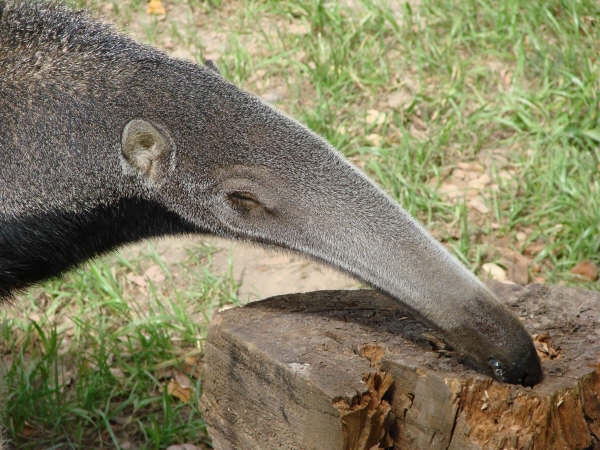Myrmecophaga tridactyla- Giant Anteater
 Nutrition
NutritionFor the most part, a giant anteaters diet is very simple. As their name implies, their main food are ants, specifically carpenter ants and other large ants, but they also feed on termites as another main source of food. They also have been know to snack on the eggs and cocoons of ants and termites as well as on the larvae of beetles and occasionally even some fruit. They stay on the ground for the most part while they are searching for food, but they may even climb a tree once in a while in search of a sweet fruit and they lick up any insect they find on the way up
The way in which they go about finding food is like that of .......SANKES...of all things?They have very reduced eyesight and hearing, but these are made up by the tongue! Although they cannot see or hear their pray the way other animals do, their tongues and noses help sense where the closest ant nest is and they guide themselves to it. As they walk, they flick their tongues in and out and sniff to catch up any stimuli of nearby food and they start heading in that direction until they find the source of the smell and start to feed.

Once it gets to the "feeding grounds" it feed like really no other animal. First, it uses its long claws to rip open the ant or termite nest and as the insects rush out, the feeding frenzy begins It extracts it long tongue, which is filled with sticky saliva and captures as many insects as it possibly can. Then it quickly pulls its tongue in before any of the insects can get off. After all of the insects are off its tongue, it extracts it again and the process starts all over.
Giant anteaters can move their tongue in and out up to 150 times per minute, maximizing the amount of insects it catches with the long tongue. Once the insects are all in the mouth, the hard gums that line the mouth start to crush the insects and once they are swallowed, the intestinal tract breaks them down even further so that the anteater can get energy and nutrition out of them. This "feeding frenzy" only lasts for about 5 minutes because many of the insects escape quickly or get gobbled up even quicker.
Although the time it takes giant anteaters to feed is not very long, many of these individual feedings per day really add up. It is estimated that giant anteaters can eat up to 30,000 ants and termites in a single day. Although this is a large number, since anteaters are not very active, they do not need much food to meet their energy need to live, and this is why a relatively big organism can feed on so many small creatures and still survive.


 All
About Them
All
About Them